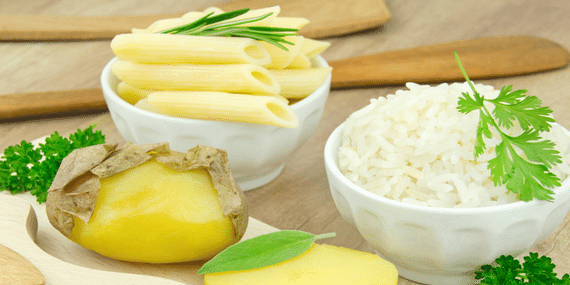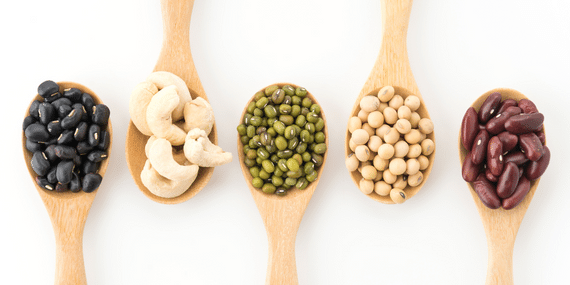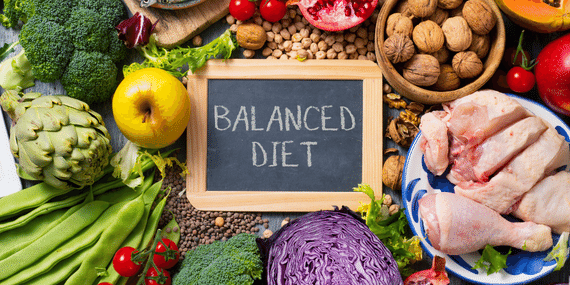
Have you heard about resistant starch foods? Resistant starch foods have gained attention as a potential tool to improve gut health and support a healthy microbiome in women over 50.
Today I’ll share what resistant starch foods are and why they are good for you! Including resistant starch is easier than you think.
What are resistant starch foods, and how do they impact health?
My client asked me the other day if I had heard of resistant starch foods. I had to admit that I didn’t, but I was curious why she was interested in resistant starch. In her case, she wanted to control her blood sugar levels as she was borderline diabetic and lost some weight.
How do resistant starch foods work?
Resistant starch is the carbohydrates you eat that are not fully digested in the small intestine and instead travel to the large intestine, where gut bacteria ferment them. This fermentation process produces short-chain fatty acids, which can help maintain a healthy gut environment and potentially provide other health benefits.
For women over 50, a diet rich in resistant starch may help alleviate common gut issues and improve overall digestive health. A healthy microbiome is also linked to many benefits, including improved immune function, reduced inflammation, and better mental health.

1. Why would you want to eat resistant starch foods?
People might want to include resistant starch in their diet for several reasons. Here are six main benefits:
- Improved gut health: Resistant starch can nourish the cells lining the gut and promote the growth of beneficial bacteria.
- Better blood sugar control: Resistant starch can improve insulin sensitivity and help regulate blood sugar levels, which may benefit people with diabetes or those at risk of developing diabetes.
- Lower cholesterol levels: Resistant starch can help lower total cholesterol levels and LDL cholesterol levels, which may reduce the risk of cardiovascular disease.
- Weight management: Resistant starch can increase feelings of fullness and reduce hunger, which may help with weight management.
- Improved nutrient absorption: Resistant starch can help improve the absorption of certain nutrients, such as calcium and magnesium, which may benefit bone health.
- Reduced inflammation: Some research suggests that resistant starch may have anti-inflammatory effects, reducing the risk of chronic diseases like cancer, heart disease, and Alzheimer’s.
All of these benefits of resistant starch foods are because the resistant starch foods you eat are not fully digested in the small intestine and instead travel to the large intestine, where gut bacteria ferment them.
However, it’s important to note that the exact benefits may vary depending on factors like the type and amount of resistant starch consumed and individual factors like genetics and overall diet.
Resources: 6 Ways to Optimize Your Health And Reduce Inflammation

2. Who can benefit from eating resistant starch?
Resistant starch may be helpful for certain digestive disorders, particularly those that involve the large intestine or colon. This is because resistant starch can act as a prebiotic, feeding the beneficial bacteria in the large intestine and promoting a healthy balance of gut bacteria.
But let’s not forget menopausal and post-menopausal women who suffer from bloating and digestive issues. Eating a diet higher in resistant starch might help alleviate those problems.
The following groups might benefit from eating resistant starch:
- People with digestive disorders like Irritable bowel syndrome (IBS) and inflammatory bowel diseases (IBD) like ulcerative colitis and diverticulitis. Resistant starch may help reduce bloating, constipation, and inflammation.
- People with insulin resistance or type 2 diabetes: Resistant starch can improve insulin sensitivity, reduce blood sugar levels, and improve glucose metabolism in people with insulin resistance or type 2 diabetes.
- People trying to lose weight: Resistant starch may reduce calorie absorption, increase feelings of fullness, and promote fat burning, all of which can aid in weight loss. You might consider including resistant starch foods during Intermittent Fasting if you’re struggling with feeling full.
- Athletes and active individuals: Resistant starch can help improve athletic performance by providing a slow and sustained release of energy, reducing fatigue, and promoting glycogen synthesis.
- Older adults: Resistant starch may help improve gut health, reduce inflammation, and enhance immune function in older adults, who are often at increased risk for digestive disorders and age-related declines in immune function.
Resources: How to manage microscopic colitis

3. What are resistant starch foods?
Here are some resistant starch foods you might already have in your pantry.
- Legumes: Beans, lentils, chickpeas, and peas
- Unripe bananas: Green bananas are high in resistant starch, while ripe bananas contain mostly digestible starch. (As a partial flour replacement, try green banana flour, plantain flour, cassava flour, or potato starch)
- Whole grains: Whole-grain bread, brown rice, and barley
- Potatoes
- Nuts and seeds: Almonds, cashews, chia seeds, and flaxseeds contain some resistant starch.
- Cooked and cooled pasta: Pasta that has been cooked and cooled contains more resistant starch than freshly
- Oats: Rolled and steel-cut oats contain resistant starch, while instant oats do not.
- Cooked and cooled rice: Similar to pasta, rice that has been cooked and cooled contains more resistant starch than freshly cooked rice.
Example: Cooking and cooling potatoes can increase their resistance to digestion, making them more starch-resistant. This occurs because the cooking heat causes the potatoes’ starch molecules to break down and re-form in a more tightly packed structure. This new structure makes the starch more resistant to digestion by enzymes in the small intestine, allowing it to pass through to the large intestine and be fermented by gut bacteria.
Simple Ideas To Add Resistant Starch to Your Diet
- Try cooking rice, potatoes, beans, and pasta a day in advance and cool in the refrigerator overnight. It’s ok to reheat the starch before eating. Reheating doesn’t decrease the amount of resistant starch.
- In place of cooked oatmeal, try uncooked oats soaked in your favorite milk, often called overnight oats.
- Add lentils to a salad or soup.
When you increase resistant starch in your diet, you must drink plenty of water to avoid digestive issues like bloating or constipation.
Resources: 5 amazing ways Intermittent Fasting helps you in midlife

4. Does resistant starch help you lose weight?
Resistant starch may help with weight loss, but the evidence is inconclusive. According to a study published in the American Journal of Clinical Nutrition, consuming resistant starch can increase feelings of fullness and reduce calorie intake by up to 10% at the next meal.
It’s also important to note that adding resistant starch to your diet is unlikely to lead to weight loss if you’re not making other changes to your diet and lifestyle, such as reducing calorie intake and increasing physical activity.
In addition, consuming too much resistant starch can cause digestive discomfort, so it’s important to start with small amounts and gradually increase intake as tolerated.
How much resistant starch should I eat per day?
How much resistant starch should we be eating? Intakes of resistant starch of 15-20 grams per day are recommended for supporting bowel health.
If you’re trying to break a weight loss plateau, have high blood sugars or digestive problems, or are simply in the mood to try something new, try out resistant starch foods.
Resources: What do you do if you’re struggling to lose weight?
What can happen when you eat too many resistant starch foods?
While resistant starch foods have many potential health benefits, consuming too much is possible, just as with any other type of food. Here are a few potential pitfalls that may arise from excessive consumption of resistant starch foods:
Overeating resistant starch can result in gas, bloating, and diarrhea, reduce the absorption of minerals like iron, calcium, and zinc, and if consumed in excess, may not improve insulin sensitivity. Also, resistant starch foods are often high in calories and can contribute to weight gain if consumed excessively.
People with kidney disease, those restricted to a low FODMAP diet, or people with allergies and sensitivities might want to avoid resistant starch.
In moderation, starch-resistant foods can be part of a healthy diet and may provide numerous health benefits.
5. Should women over 50 and 60 eat resistant starch?
Women in menopause and post-menopause may benefit from consuming resistant starch as part of a healthy diet, as with any dietary change. If you’re stuck losing weight and need to shake it up, want to improve your gut health, reduce inflammation, and reduce the risk of type 2 diabetes and cardiovascular disease risk, then resistant starch foods are worth a try.
Resistant starch can be helpful for menopausal and post-menopausal women. Use it as part of a healthy, balanced diet that includes a variety of fruits, vegetables, whole grains, lean protein, and healthy fats.
Resources: The easy-to-follow intermittent fasting guide for newbies
Adding resistant starch foods into your diet and nutrition is an excellent choice for your gut health and provides many benefits. As mentioned, go slow by introducing one resistant starch food into our meals and see how you tolerate it. If you have health concerns and are unsure if you should add resistant starch food to your diet, consult your doctor before trying.

Additionally, it’s important to consume resistant starch as part of a healthy, balanced diet that includes a variety of nutrients. When increasing fiber in your diet, don’t add them all at once and go slowly. Don’t forget to drink plenty of water to reduce GI side effects.
Remember, all types of fiber have health benefits, so eat a variety of fiber-containing foods.

I have not heard of resistant starch before!
I didn’t know that cooling potatoes and rice makes them resistant starches!
Great information!
Robin, that was an eye-opener for me too.
I have not heard of this.This is timely and interesting, as i have Gastroperesis and I am doing a test at home about my gut biome and seeing if I have an imbalance. This was interesting to read. Im pinning it!
jess xx
http://www.elegantlydressedandstylish.com
Jess, I’m glad I can share this information with you, and I hope it’s helpful for you.
Great post!
Hi Maria, thanks for stopping by.
Comments are closed.